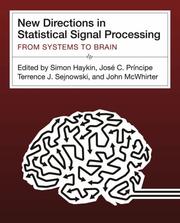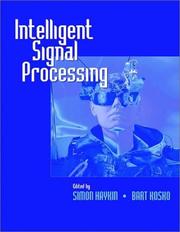| Listing 1 - 6 of 6 |
Sort by
|

ISBN: 9786612096372 1282096370 0262256312 1429418737 9780262256315 9780262083485 0262292793 9781429418737 0262083485 9780262292795 6612096373 9781282096370 Year: 2007 Publisher: Cambridge, Mass. MIT Press
Abstract | Keywords | Export | Availability | Bookmark
 Loading...
Loading...Choose an application
- Reference Manager
- EndNote
- RefWorks (Direct export to RefWorks)
Signal processing and neural computation have separately and significantly influenced many disciplines, but the cross-fertilization of the two fields has begun only recently. Research now shows that each has much to teach the other, as we see highly sophisticated kinds of signal processing and elaborate hierachical levels of neural computation performed side by side in the brain. In New Directions in Statistical Signal Processing, leading researchers from both signal processing and neural computation present new work that aims to promote interaction between the two disciplines. The book's 14 chapters, almost evenly divided between signal processing and neural computation, begin with the brain and move on to communication, signal processing, and learning systems. They examine such topics as how computational models help us understand the brain's information processing, how an intelligent machine could solve the "cocktail party problem" with "active audition" in a noisy environment, graphical and network structure modeling approaches, uncertainty in network communications, the geometric approach to blind signal processing, game-theoretic learning algorithms, and observable operator models (OOMs) as an alternative to hidden Markov models (HMMs).
Neural networks (Neurobiology) --- Neural networks (Computer science) --- Signal processing --- Neural computers. --- Statistical methods. --- Neural net computers --- Neural network computers --- Neurocomputers --- Artificial neural networks --- Nets, Neural (Computer science) --- Networks, Neural (Computer science) --- Neural nets (Computer science) --- Biological neural networks --- Nets, Neural (Neurobiology) --- Networks, Neural (Neurobiology) --- Neural nets (Neurobiology) --- Electronic digital computers --- Natural computation --- Artificial intelligence --- Soft computing --- Cognitive neuroscience --- Neurobiology --- Neural circuitry --- COMPUTER SCIENCE/Machine Learning & Neural Networks --- NEUROSCIENCE/General --- Neural networks (Computer science). --- Neural networks (Neurobiology).
Book
ISBN: 9781139127516 1139127519 9781139114684 1139114689 9780511818363 051181836X 9781139116855 1139116851 9780521114363 0521114365 1107212731 1280878886 1139122592 9786613720191 113911249X Year: 2012 Publisher: Cambridge New York Cambridge University Press
Abstract | Keywords | Export | Availability | Bookmark
 Loading...
Loading...Choose an application
- Reference Manager
- EndNote
- RefWorks (Direct export to RefWorks)
The principles of cognition are becoming increasingly important in the areas of signal processing, communications and control. In this groundbreaking book, Simon Haykin, a pioneer in the field and an award-winning researcher, educator and author, sets out the fundamental ideas of cognitive dynamic systems. Weaving together the various branches of study involved, he demonstrates the power of cognitive information processing and highlights a range of future research directions. The book begins with a discussion of core topics such as cognition and sensing, dealing, in particular, with the perception-action cycle. Bayesian filtering, machine learning and dynamic programming are then addressed. Building on these foundations, there is detailed coverage of two important practical applications, cognitive radar and cognitive radio. Blending theory and practice, this insightful book is aimed at all graduate students and researchers looking for a thorough grounding in this fascinating field.
Self-organizing systems. --- Cognitive radio networks. --- Ad hoc cognitive networks (Wireless communication systems) --- Cognitive networks (Wireless communication systems) --- Ad hoc networks (Computer networks) --- Self-organizing systems --- Learning systems (Automatic control) --- Self-optimizing systems --- Cybernetics --- Intellect --- Learning ability --- Synergetics
Book
ISBN: 1282259350 9786612259357 0470443634 0470443626 9780471209218 047120921X 9780470443637 Year: 2009 Publisher: Hoboken, New Jersey Wiley :
Abstract | Keywords | Export | Availability | Bookmark
 Loading...
Loading...Choose an application
- Reference Manager
- EndNote
- RefWorks (Direct export to RefWorks)
Discover cutting-edge research in wireless communications This book presents cutting-edge research in wireless communications, particularly in the fast-growing subject of multiple-input multiple-output (MIMO) wireless communication systems. It begins with an introduction, which includes historical notes and a review of turbo-information processing and MIMO wireless communications, and goes on to cover: . MIMO channel capacity. BLAST architectures. Space-time turbo codes and turbo decoding principles. Turbo-BLAST. Turbo-MIMO systems The material is complemented with abundant illustrations and computer experiments that are designed to help readers reinforce their understanding of the underlying subject matter. Space-Time Layered Information Processing for Wireless Communications is an ideal resource for researchers in academia and industry and an excellent textbook for related courses at the graduate level.
Book
ISBN: 1282656503 9786612656507 0470575751 0470575743 9780470575758 9780470195178 0470195177 Year: 2010 Publisher: New York [Piscataqay, New Jersey] IEEE, Institute of Electrical and Electronics Engineers IEEE Xplore
Abstract | Keywords | Export | Availability | Bookmark
 Loading...
Loading...Choose an application
- Reference Manager
- EndNote
- RefWorks (Direct export to RefWorks)
Leading experts present the latest research results in adaptive signal processing Recent developments in signal processing have made it clear that significant performance gains can be achieved beyond those achievable using standard adaptive filtering approaches. Adaptive Signal Processing presents the next generation of algorithms that will produce these desired results, with an emphasis on important applications and theoretical advancements. This highly unique resource brings together leading authorities in the field writing on the key topics of significance, each at the cutti
Book
ISBN: 1282549324 9786612549328 1613445016 0470487062 0470487054 9780470487068 9780470371763 9780470487051 Year: 2009 Publisher: [Piscataway, New Jersey] [Piscataqay, New Jersey] IEEE IEEE Xplore
Abstract | Keywords | Export | Availability | Bookmark
 Loading...
Loading...Choose an application
- Reference Manager
- EndNote
- RefWorks (Direct export to RefWorks)
A handbook on recent advancements and the state of the art in array processing and sensor Networks Handbook on Array Processing and Sensor Networks provides readers with a collection of tutorial articles contributed by world-renowned experts on recent advancements and the state of the art in array processing and sensor networks. Focusing on fundamental principles as well as applications, the handbook provides exhaustive coverage of: wavelets; spatial spectrum estimation; MIMO radio propagation; robustness issues in sensor array processing; wireless communications and sensing

ISBN: 9780470544976 9780780360105 047054497X Year: 2001 Publisher: New York [Piscataqay, New Jersey] IEEE Press IEEE Xplore
Abstract | Keywords | Export | Availability | Bookmark
 Loading...
Loading...Choose an application
- Reference Manager
- EndNote
- RefWorks (Direct export to RefWorks)
"IEEE Press is proud to present the first selected reprint volume devoted to the new field of intelligent signal processing (ISP). ISP differs fundamentally from the classical approach to statistical signal processing in that the input-output behavior of a complex system is modeled by using "intelligent" or "model-free" techniques, rather than relying on the shortcomings of a mathematical model. Information is extracted from incoming signal and noise data, making few assumptions about the statistical structure of signals and their environment. Intelligent Signal Processing explores how ISP tools address the problems of practical neural systems, new signal data, and blind fuzzy approximators. The editors have compiled 20 articles written by prominent researchers covering 15 diverse, practical applications of this nascent topic, exposing the reader to the signal processing power of learning and adaptive systems. This essential reference is intended for researchers, professional engineers, and scientists working in statistical signal processing and its applications in various fields such as humanistic intelligence, stochastic resonance, financial markets, optimization, pattern recognition, signal detection, speech processing, and sensor fusion. Intelligent Signal Processing is also invaluable for graduate students and academics with a background in computer science, computer engineering, or electrical engineering. About the Editors Simon Haykin is the founding director of the Communications Research Laboratory at McMaster University, Hamilton, Ontario, Canada, where he serves as university professor. His research interests include nonlinear dynamics, neural networks and adaptive filters and their applications in radar and communications systems. Dr. Haykin is the editor for a series of books on "Adaptive and Learning Systems for Signal Processing, Communications and Control" (Publisher) and is both an IEEE Fellow and Fellow of the Royal Society of Canada. Bart Kosko is a past director of the University of Southern California's (USC) Signal and Image Processing Institute. He has authored several books, including Neural Networks and Fuzzy Systems, Neural Networks for Signal Processing (Publisher, copyright date) and Fuzzy Thinking (Publisher, copyright date), as well as the novel Nanotime (Publisher, copyright date). Dr. Kosko is an elected governor of the International Neural Network Society and has chaired many neural and fuzzy system conferences. Currently, he is associate professor of electrical engineering at USC.".
Signal processing --- Intelligent control systems. --- Adaptive signal processing. --- Digital techniques.
| Listing 1 - 6 of 6 |
Sort by
|

 Search
Search Feedback
Feedback About UniCat
About UniCat  Help
Help News
News